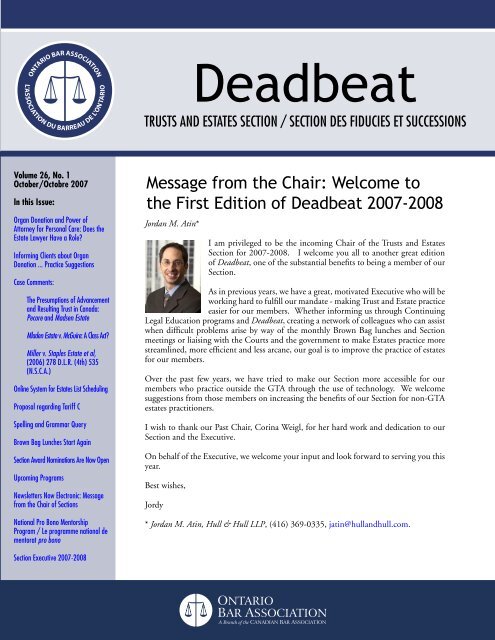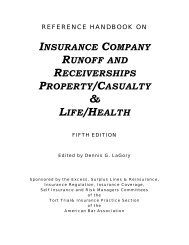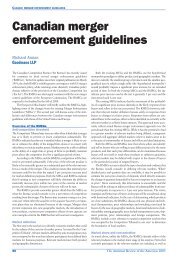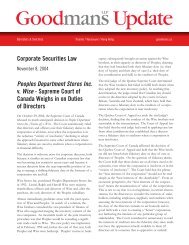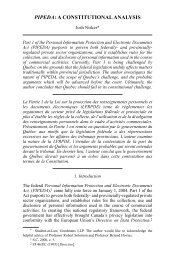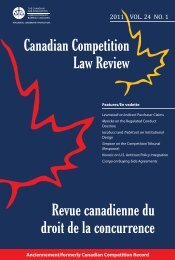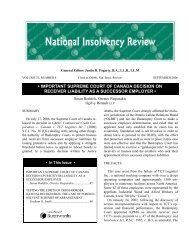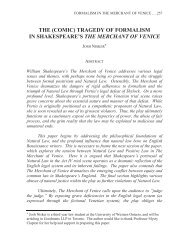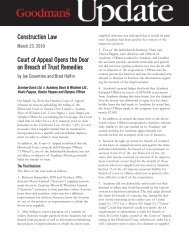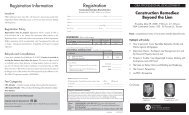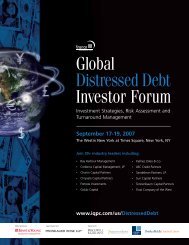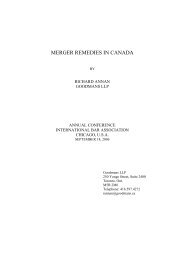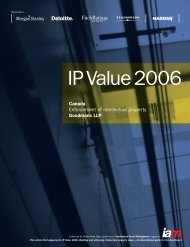Deadbeat - Goodmans
Deadbeat - Goodmans
Deadbeat - Goodmans
You also want an ePaper? Increase the reach of your titles
YUMPU automatically turns print PDFs into web optimized ePapers that Google loves.
<strong>Deadbeat</strong><br />
TRUSTS AND ESTATES SECTION / SECTION DES FIDUCIES ET SUCCESSIONS<br />
Volume 26, No. 1<br />
October/Octobre 2007<br />
In this Issue:<br />
Organ Donation and Power of<br />
Attorney for Personal Care: Does the<br />
Estate Lawyer Have a Role?<br />
Informing Clients about Organ<br />
Donation ... Practice Suggestions<br />
Case Comments:<br />
The Presumptions of Advancement<br />
and Resulting Trust in Canada:<br />
Pecore and Madsen Estate<br />
Mladen Estate v. McGuire: A Class Act?<br />
Miller v. Staples Estate et al,<br />
(2006) 278 D.L.R. (4th) 535<br />
(N.S.C.A.)<br />
Online System for Estates List Scheduling<br />
Proposal regarding Tariff C<br />
Spelling and Grammar Query<br />
Brown Bag Lunches Start Again<br />
Section Award Nominations Are Now Open<br />
Upcoming Programs<br />
Newsletters Now Electronic: Message<br />
from the Chair of Sections<br />
National Pro Bono Mentorship<br />
Program / Le programme national de<br />
mentorat pro bono<br />
Message from the Chair: Welcome to<br />
the First Edition of <strong>Deadbeat</strong> 2007-2008<br />
Jordan M. Atin*<br />
I am privileged to be the incoming Chair of the Trusts and Estates<br />
Section for 2007-2008. I welcome you all to another great edition<br />
of <strong>Deadbeat</strong>, one of the substantial benefits to being a member of our<br />
Section.<br />
As in previous years, we have a great, motivated Executive who will be<br />
working hard to fulfill our mandate - making Trust and Estate practice<br />
easier for our members. Whether informing us through Continuing<br />
Legal Education programs and <strong>Deadbeat</strong>, creating a network of colleagues who can assist<br />
when difficult problems arise by way of the monthly Brown Bag lunches and Section<br />
meetings or liaising with the Courts and the government to make Estates practice more<br />
streamlined, more efficient and less arcane, our goal is to improve the practice of estates<br />
for our members.<br />
Over the past few years, we have tried to make our Section more accessible for our<br />
members who practice outside the GTA through the use of technology. We welcome<br />
suggestions from those members on increasing the benefits of our Section for non-GTA<br />
estates practitioners.<br />
I wish to thank our Past Chair, Corina Weigl, for her hard work and dedication to our<br />
Section and the Executive.<br />
On behalf of the Executive, we welcome your input and look forward to serving you this<br />
year.<br />
Best wishes,<br />
Jordy<br />
* Jordan M. Atin, Hull & Hull LLP, (416) 369-0335, jatin@hullandhull.com.<br />
Section Executive 2007-2008
Home<br />
Organ Donation and Power of Attorney for Personal<br />
Care: Does the Estate Lawyer Have a Role?<br />
Irit Gertzbein*<br />
The purpose of this article is to examine the extent to which estate lawyers may play a role, if any, in the<br />
implementation of the existing first-person consent regime for post-mortem anatomical gifting, in light of<br />
relevant legislation and current practice in hospitals to not act on a deceased’s written consent to donate organs<br />
in the face of a family member’s objection. 1 The overriding question is, what, if any, is the estate lawyer’s role<br />
vis-à-vis a client’s wish to donate organs after death, given the application of relevant statutes to the practice of<br />
organ donation?<br />
BACKGROUND<br />
In Canada, the “opt in” system of organ donation, also known as the first-person consent regime, is the means<br />
by which patients requiring healthy organs or tissues to sustain or enhance their life receive matched organs or<br />
tissues from voluntary donors. The Trillium Gift of Life Network Act (“TGLNA”) governs the first-person consent<br />
regime in Ontario, while the Trillium Gift of Life Network (“TGLN”) is the facilitating organization.<br />
In response to increase in demand for organs, organizations dealing with organ donations have, often unsuccessfully,<br />
proposed various modifications to the first-person consent regime in an effort to improve organ donations in<br />
Canada. Particularly, organizations such as the TGLN have attempted to enlist the cooperation of estate lawyers.<br />
Specifically, it has been suggested that in order to firstly, increase supply and secondly, to prevent frustration<br />
of donors’ intentions, estate lawyers should encourage clients to utilize a Power of Attorney for Personal Care<br />
(“POAPC”) as a tool to convey their intentions to donate.<br />
LEGISLATIVE CONTEXT<br />
Trillium Gift of Life Network Act (“TGLNA”) 2<br />
First-person consent for inter-vivos organ donation requires consent in writing 3 by a person who is at least sixteen<br />
years of age and mentally competent. Consent for post-mortem organ donation may be given either in writing<br />
or, orally in the presence of two witnesses during the person’s last illness. 4 Written consent is full consent with<br />
statutory authority to be enforced. 5 Section 1 of the TGLNA defines a “writing” for the purposes of Part II to<br />
include a will and any other testamentary instrument whether or not probate has been applied for or granted<br />
and whether or not the will or other testamentary instrument is valid. The effect of this definition is that in<br />
essence, “any writing will do”. The nature of the document per se is irrelevant. 6<br />
Where a deceased did not give consent, the TGLNA limits authority to consent to donate to a spouse, a child at<br />
least 16 years of age, a parent, sibling, more remote next-of-kin, or a person lawfully in possession of the body. 7<br />
This is to be distinguished from authority to consent by a substitute decision maker (“SDM”) under a POAPC,<br />
as discussed below.<br />
Substitute Decisions Act, 1992 (“SDA”) 8 and POAPC<br />
Should organ donations be dealt with in a POAPC? POAPCs are dealt with in the SDA. The SDA provides<br />
authority to a SDM under a POAPC to make decisions on behalf of the grantor concerning personal care, 9 health<br />
care, nutrition, shelter, clothing, hygiene or safety, keeping in mind the best interest of the grantor, 10 while he or<br />
she is incapable. Whatever the nature of the decision, it must be within the rubric of enhancing or sustaining<br />
the health and life of the grantor. Making a post-mortem organ donation in no way fits within this mandate.<br />
Section 66(14) of the SDA, addressing sterilization and transplants, states:<br />
2 <strong>Deadbeat</strong> • Volume 26, No. 1
Home<br />
(14) Nothing in this Act affects the law relating to giving or refusing consent on another person’s behalf to<br />
one of the following procedures:<br />
1. …<br />
2. The removal of regenerative or non-regenerative tissue for implantation in another person’s body.<br />
Clearly, the SDA does not provide authority to a SDM under a POAPC to make decisions regarding the donation<br />
of organs of the grantor.<br />
ANALYSIS<br />
The raison d’être of a POAPC is to authorize substitution of the decision maker, to replace the first-person<br />
decision maker with a third party decision maker. The authority for such delegation of decision-making as<br />
expressed in the instrument itself is rooted in the SDA. Since neither the SDA nor the TGLNA contemplate a<br />
grantor’s delegation of decision making to consent to organ donation, the use of a POAPC under the SDA with<br />
respect to organ donation is an inappropriate use of a POAPC as the SDA does not apply to matters involving<br />
transplantation. However, if part of a POAPC, among other things, states the first-person’s consent to organ<br />
donation after death, it is “a writing” which constitutes written consent to donate. Clearly, in the latter example,<br />
the document is used as a vehicle to record consent and not as a POAPC. That an attorney is named in that<br />
POAPC is irrelevant. Hence, when advocating the use of a POAPC regarding post-mortem organ donation it<br />
is important to clarify that such instructions are enforceable (barring family objection) not because a POAPC<br />
is used as the vehicle, but rather, because the instructions are first person written consent, in compliance with<br />
the TGLNA.<br />
ADVISING CLIENTS<br />
The rationale for providing written instructions to donate organs after death in a POAPC is that this document<br />
is likely to be examined by hospital staff and family prior to death while the same instructions provided for in<br />
a Will may not be read until after burial of the deceased, thus frustrating the donor’s intentions. However, to<br />
achieve the proper timing does not require the use of a POAPC. It is possible to achieve the same results by<br />
advising clients who are executing a POAPC and have expressed a wish to donate organs after death, to provide<br />
written instructions to that effect, perhaps attached as a Memorandum to the POAPC and referred to in the<br />
POAPC. This approach may reduce misunderstanding by the client, his or her family and the public at large,<br />
with respect to the role of the POAPC regarding the intended organ donation. Separating the contents of<br />
the documents demonstrates their independent legal status, while the physical attachment (by a paper clip for<br />
example) achieves the timing goal.<br />
Finally and perhaps most significantly, the estate lawyer may emphasize to the client that notwithstanding the<br />
existence of written consent or oral consent to two witnesses during time of illness, objection from a family<br />
member will prevent a hospital from harvesting the donated organs. Informing close family members of intentions<br />
to donate and requesting that they do not thwart them may be the clients’ best way to ensure that their wishes<br />
are followed.<br />
CONCLUSION<br />
In the context of post-mortem organ donation the provisions of the SDA are inapplicable. The sole statute<br />
governing consent to post-mortem organ donations is the TGLNA, which, while providing for consent by third<br />
party family members in the absence of first party consent, does not contemplate consent by an attorney pursuant<br />
to a POAPC. Furthermore, notwithstanding binding written consent by the potential donor, hospitals do not<br />
carry out those wishes if there is objection from the family.<br />
<strong>Deadbeat</strong> • October 2007 3
Home<br />
Estate lawyers’ role in advising clients on these matters is limited. When clients raise questions regarding the<br />
use of a POAPC for purposes of organ donation after death, the lawyer’s advice should reflect the distinction<br />
between delegation of decision-making authority in a POAPC, and written consent provided in writing under<br />
the TGLNA. In the context of organ donation, the former cannot be done. With respect to the unsettled state<br />
of affairs given the legislative context and public policy considerations, at best, the lawyer may, by encouraging<br />
the client to convey his or her wishes to close family members, increase the likelihood that the client’s wishes<br />
will be honoured after death.<br />
* Irit Gertzbein, Torkin Manes Cohen Arbus LLP.<br />
1<br />
Confirmed by Jennifer Tracy, Director of Public Affairs and Communication, Trillium Gift of Life Network,<br />
in discussions with the author.<br />
2<br />
Trillium Gift of Life Network Act, R.S.O. 1990, CHAPTER H.20<br />
3<br />
TGLNA, s. 3(1)<br />
4<br />
ibid, s. 4(1)(a) and (b)<br />
5<br />
ibid, s. 3(3)<br />
6<br />
See website www.giftoflife.on.ca of the TGLN for its suggested form of writing.<br />
7<br />
TGLNA, s. 5(2)<br />
8<br />
Substitute Decisions Act, 1992, S.O. 1992, CHAPTER 30, as amended.<br />
9<br />
SDA s. 49(1)<br />
10<br />
ibid s. 66(4)<br />
Informing Clients about Organ Donation …<br />
Practice Suggestions<br />
Jan Goddard*<br />
If you want to encourage your clients to sign organ donor consent forms, here are some tips:<br />
• Keep a supply of Trillium Gift for Life brochures in a stand in your firm’s meeting or reception<br />
area (or both) to attract attention from all clients, not just estate planning clients<br />
• Add a question about organ donation to your will questionnaire or interview sheet. For example:<br />
Would you like information about organ donation?<br />
• Offer to make copies of a client’s signed donor card and suggest that copies be attached to or<br />
stored with other estate planning documents such as the client’s power of attorney for personal care<br />
or will<br />
• Encourage clients to discuss their wishes regarding organ donation with family members, and offer<br />
extra copies of the brochure for them to distribute to other family members<br />
* Jan Goddard, Jan Goddard & Associates, (416) 928-6685, jgoddard@jangoddardlaw.com.<br />
4 <strong>Deadbeat</strong> • Volume 26, No. 1
Home<br />
The Presumptions of Advancement and Resulting<br />
Trust in Canada: Pecore and Madsen Estate 1<br />
Susan J. Heakes*<br />
A potential client comes to your office for advice. Her father has just passed away. She has been managing his<br />
affairs for a number of years under a power of attorney. She and her father had established a joint bank account<br />
which consisted of her father’s money. The account included notice of a right of survivorship. She wants to know<br />
what will happen to the money in the account.<br />
Many would probably respond by explaining that absent evidence to the contrary, the money belongs to the<br />
survivor, and until recently, that advice would have been basically correct. In two recent cases, Pecore 2 and Madsen<br />
Estate, 3 the Supreme Court of Canada abolished the presumption of advancement to an adult child in favour of<br />
the presumption of resulting trust. In practical terms, the new starting point where an adult child holds the joint<br />
account with the parent is that the funds are now held for the benefit of the deceased co-owner, i.e. the estate.<br />
This change to trust and estate jurisprudence will have a direct impact on the lives of many Canadian families<br />
and their long-term estate planning.<br />
Pecore v. Pecore<br />
In the mid 1990’s, Mr. Hughes, a retired miner from Timmins, Ontario began to transfer his assets to new<br />
accounts jointly owned by him and his daughter Paula Pecore. Mr. Hughes continued to manage and control<br />
the joint accounts on a day-to-day basis.<br />
Mr. Hughes’ investment advisors had told him that by placing his assets in joint ownership with a right to<br />
survivorship, he could avoid the payment of probate fees and taxes. This process was thought to make after-death<br />
disposition both less difficult and costly. Despite this advice, Mr. Hughes became concerned that such transfers<br />
to Paula might be considered deemed dispositions by Revenue Canada (as it was then called) thereby triggering<br />
the immediate payment of capital gains taxes. As a result, he sent letters to the various institutions where he<br />
had joint accounts, advising that the change in ownership had been done for probate purposes only and that<br />
there was no intention of a gift to his daughter. Mr. Hughes’ will left the residue of his estate to several people,<br />
including Paula’s husband, Michael Pecore. Michael Pecore took the position that based upon the equitable<br />
presumption of resulting trust, the assets from the joint accounts should revert to the estate and be distributed<br />
through the terms of the will.<br />
At trial, Karam J. found that the presumption of advancement applied and that Michael Pecore had failed to rebut<br />
the presumption of advancement. On appeal, the trial judgment was upheld. 4 The Court of Appeal reviewed the<br />
law respecting presumptions of resulting trust and advancement and concluded that these presumptions were<br />
only relevant when evidence of actual intention was not present or sufficient. Where joint ownership of assets is<br />
at issue, resorting to the presumption will rarely, if ever, be necessary. 5<br />
Madsen Estate v. Saylor<br />
Mr. Madsen held joint bank accounts with one of his three children, Patricia Brooks. The question at trial was<br />
whether the value of these accounts should be included in his estate, or whether the monies belonged to Ms.<br />
Brooks upon his death.<br />
According to his will, Mr. Madsen’s estate was to be divided into two equal shares: one to be equally distributed to<br />
his three children; and the other to be equally distributed to his eight grandchildren. Ms. Brooks was the only child<br />
named as an executor of the will and was also previously appointed as Mr. Madsen’s power of attorney. Prior to<br />
his death Mr. Madsen made Ms. Brooks the joint signatory on his bank accounts with a right of survivorship.<br />
<strong>Deadbeat</strong> • October 2007 5
Home<br />
At trial, the court found that Ms. Brooks was evasive and gave conflicting evidence. 6 The judge found no<br />
evidence to support the position that her father intended to gift the contents of the joint account to her. 7 After<br />
reviewing the presumption of resulting trust and the presumption of advancement, the court concluded that the<br />
presumption of advancement from parent to child should be abandoned in favour of resulting trust in all but the<br />
most limited cases. 8 The historical justification for the presumption of advancement was financial dependence;<br />
thus, where the parent is elderly and the child is an adult, dependence does not exist and the presumption should<br />
not apply. 9<br />
On appeal, Laforme J.A. concluded that the presumption of advancement can apply to transfers of property<br />
from a parent to a child, including an independent adult child. 10 The trial judge was therefore incorrect when<br />
she applied the law of resulting trust. The trial judge’s error was moot, however, as the majority found ample<br />
evidence to suggest that the contents of the joint accounts were not intended to be a gift to Ms. Brooks, thereby<br />
not requiring an application of the presumption of advancement. 11<br />
In her dissent, Feldman J.A. thoughtfully examined the social and practical implications of judicial interference<br />
with the presumption of advancement. She suggested that to the extent that the existing law is flawed, it was<br />
the legislature that must address such issues, as it did with the presumptions in the context of spouses. In the<br />
meanwhile, she suggested, that the presumptions of resulting trust and advancement provide certainty and<br />
predictability to the increasingly common dilemma of the beneficial ownership of joint accounts.<br />
New Direction for Presumptions from the Supreme Court of Canada<br />
The Supreme Court of Canada released their decisions in Pecore and Madsen on May 3, 2007. The reasons for<br />
the majority are found in Pecore, where Rothstein J. writes for the majority.<br />
At the outset, Rothstein J. notes that joint accounts between parents and their children have become common<br />
estate planning tools. Each joint tenant may be able to withdraw any or all of the funds and each may have a<br />
right of survivorship. Given their widespread use for estate purposes, many commentators have referred to joint<br />
accounts as ‘the poor man’s will’.<br />
Regardless of how the general public understands joint accounts, the courts of equity distinguish between legal<br />
and beneficial ownership. This distinction is drawn by the intention of the transferor at the time of transfer.<br />
Unfortunately, intention is often difficult to ascertain, especially when the transferor is deceased. 12<br />
Rothstein J. explored the origins of the presumption of advancement and found it to be a tool whereby a parent<br />
could transfer assets to a child. But what happens when the children are adults and financially independent of<br />
their parents? Rothstein J. examined a number of recent cases, including McLear v. McLear Estate where the<br />
court held that it is dangerous to presume that an elderly parent is making a gift. 13 One of the concerns expressed<br />
in McLear was that in modern times, the joint account may have a purpose other than succession planning:<br />
the management of the elder’s finances in later years. Rothstein J. adopted the rationale behind these cases and<br />
held that where there is no parental obligation to support their children, it is wrong to assume that the parent<br />
intended to advance the child through a gift.<br />
The Dissent<br />
In a strongly worded dissent, Abella J. tried to preserve the presumption of advancement. She noted the<br />
longevity of the presumption of advancement in English and Canadian jurisprudence and concluded that there<br />
was no reason to limit the presumption of advancement to non-adult children or to remove the presumption of<br />
advancement from the “judicial toolbox” in assessing intention. 14<br />
Abella J. challenged Rothstein J.’s rejection of parental affection as a basis of the presumption of advancement. In<br />
cases from Grey (Lord) in 1677 to the modern extended family drama in Yao, the presumption of advancement had<br />
been based upon “natural consideration of blood and affection” not solely on financial dependence. 15 Historically,<br />
this “affection” applied to adult children as well as minor children.<br />
6 <strong>Deadbeat</strong> • Volume 26, No. 1
Home<br />
From a policy perspective, Abella J. considered that people today are living longer and they are using joint<br />
ownership as a mechanism to manage their daily financial affairs. She stated that there was a “flawed syllogism” 16<br />
in the argument that using joint accounts as a means of financial management was inconsistent with survivorship<br />
and a gift.<br />
Practical Advice to Litigators Resulting from these Decisions<br />
Litigators can now use Pecore and Madsen for guidance on the types of evidence the courts will consider and<br />
value when determining intention. The following is a brief checklist to consider when asked what will happen<br />
to the monies in the joint account upon the death of an owner:<br />
1. Obtain records from the financial institution where the joint account is held, particularly the account<br />
agreement and account statements that record the activity in the account.<br />
2. Find out which employees of the financial institution may have interacted with the deceased and interview<br />
these employees as soon as possible.<br />
3. Look to the deceased’s other bank accounts, as they may be instructive in the estate and financial planning<br />
objectives of the deceased.<br />
4. Review the issues of use and control of the account.<br />
5. Obtain a copy of the deceased’s will and previous wills.<br />
6. Obtain a copy of any of the deceased’s powers of attorney.<br />
7. Obtain copies of the deceased’s and survivor’s tax returns, notices of assessment, and reassessment after<br />
the joint account was established (to determine how the joint account was treated for tax purposes).<br />
8. Interview witnesses at the outset – especially any accountants or financial advisors. The concern is<br />
twofold: first, as the issue of resulting trust is fact-driven, one cannot advise the client properly without<br />
an understanding of all of the evidence. Second, many of the witnesses may be elderly and in poor health.<br />
Judges in these cases generally prefer the evidence of non-parties or non-family members.<br />
9. Relationships in the family are relevant; however, try not to become distracted by the intra-family<br />
squabbles. This is only a small part of the puzzle.<br />
10. Your client’s claim arises in equity and the defence of laches may apply. 17 If acting for the survivor, if<br />
there has been a delay prior to your retainer, consider how much time you have before further delay may<br />
prejudice your client.<br />
The Supreme Court of Canada has given the courts extensive discretion in these cases. While credibility is always<br />
an important consideration for the courts, it is magnified in these cases. This is especially true now that the court<br />
can consider evidence of intention after the joint account was established.<br />
Advice to Banks and Other Financial Institutions<br />
Rothstein J. and several other judges were very critical of the language used in account agreements respecting<br />
survivorship, commenting that they were confusing and ambiguous. Banks and other financial institutions<br />
should retain a lawyer familiar with this area of law to review their account forms. These institutions must also<br />
consider how to clearly communicate the implications of entering a joint account to their customers. Finally,<br />
as the employees of these institutions may be required to provide testimony, the financial institutions should<br />
consider how to record and retain information they have received from the account holder. 18<br />
<strong>Deadbeat</strong> • October 2007 7
Home<br />
Conclusion<br />
The shift to the presumption of resulting trust from the presumption of advancement, combined with the<br />
expanded evidentiary scope of the inquiry into transfers to joint accounts, will result in less certainty for the users<br />
of joint accounts. This may have a disproportionate impact on some members of society as joint accounts were<br />
often used as inexpensive estate planning tools (‘the poor man’s will’). It may be that “transactional certainty” will<br />
have to be legislated, as it was for real property. Until then, professionals such as lawyers, bankers and financial<br />
advisors will have to take this new legal regime into account when dealing with intergenerational transfers of<br />
wealth to ensure the transferors’ true intentions are respected upon their death.<br />
* Susan J. Heakes, Discipline Counsel, Law Society of Upper Canada.<br />
1<br />
This article represents the opinion of the author and does not represent or embody the official position of the<br />
Law Society of Upper Canada.<br />
2<br />
2007 SCC 17 No. 31202; [2005] O.J. No. 3712 Docket: C41774 (C.A.); (2004), 48 R.F.L. (5th) 89 (Ont.<br />
S.C.J.) [Pecore]<br />
3<br />
2007 SCC 18 No. 31262; (2005), 261 D.L.R. (4th) 597 (Ont. C.A.); (2004), 13 E.T.R. (3d) 44 (Ont. S.C.J.).<br />
[Madsen]<br />
4<br />
Pecore v. Pecore, [2005] O.J. No. 3712 Docket: C41774 (C.A.), Weiler K.M., Rosenberg M., and Lang S.E., JJ.A.)<br />
5<br />
Ibid. at para. 9.<br />
6<br />
Saylor v. Madsen Estate (2004), 13 E.T.R. (3d) 44 (Ont. S.C.J.) at para. 51.<br />
7<br />
Ibid. at para. 58.<br />
8<br />
Ibid. at para. 24.<br />
9<br />
Ibid. at paras. 24 and 36. To add salt to the wound, the trial judge held that by retaining the monies from the<br />
joint account, Paula Pecore was in breach of her fiduciary obligations as an executor of her father’s estate. This<br />
seems harsh, when the state of the law was in flux. The Court of Appeal reversed this finding.<br />
10<br />
Madsen Estate (2005), 261 D.L.R. (4th) 597 at para. 19 (Ont. C.A.) at para. 21.<br />
11<br />
Ibid. at para. 23.<br />
12<br />
Pecore, supra note 3 at para. 5.<br />
13<br />
McLear v. McLear Estate, [2000] O.J. No. 2570 (S.C.J.) at para. 34.<br />
14<br />
Pecore, supra note 3 at para 82.<br />
15<br />
Grey (Lord) v. Lady Grey (1677) at 743; Cho Ki Yao (Trustee of) v. Yao Estate [1999] O.J. No. 3813 (S.C.J.)(QL)<br />
[Cho cited to QL]<br />
16<br />
Pecore, supra note 3 at para. 100.<br />
17<br />
Fonesca v. Jones, (1910), 14WLR148, 21 Man. R. 168 (K.B.), aff’d (1911), 18 WLR 259, 21 Man. R. 168 at<br />
193 (C.A.).<br />
18<br />
Added to this problem is the reality that the employee who may have originally dealt with the account holder<br />
may no longer be with the institution. It all comes back, to the financial institution having clearly worded<br />
account agreements and forms.<br />
8 <strong>Deadbeat</strong> • Volume 26, No. 1
Home<br />
Mladen Estate v. McGuire: A Class Act?<br />
Barry S. Corbin*<br />
The recent case of Mladen Estate v. McGuire, 2007CarswellOnt 1976 (S.C.J.) is a compelling example – as if we<br />
did not have more than enough already – of the problems that can result from poor will drafting. At a minimum,<br />
it can give rise to additional costs to the estate. At worst, it may result in a distribution of the estate that is not<br />
in accordance with what the client intended. The only uncertainty is whether the burden of the resulting loss<br />
suffered by the “disappointed beneficiary” will, by means of a successful negligence claim, be transferred to the<br />
shoulders of the solicitor who drafted the will.<br />
In Mladen, Belobaba, J. was faced with the task of interpreting Shirley Mladen’s will (drawn by her solicitor) that<br />
directed the residue of her estate to go to her mother and, if her mother predeceased her, further directed that<br />
it be “divided among my Aunt Bea Peterson as to a 50% share, my cousin Bonnie McGuire as to a 25% share<br />
and my cousin Roger Bird as to the remaining 25% share.” Shirley’s mother did predecease her. The difficulty<br />
arose because Bea Peterson also predeceased Shirley. As a result, it became necessary to answer the question<br />
as to whether Bea Peterson’s share of the residue should (i) pass as on an intestacy; or (ii) pass to the other two<br />
named beneficiaries.<br />
According to the evidence, Shirley’s solicitor recognized the prospect of a partial intestacy resulting from Bea<br />
Peterson’s predecease. He urged Shirley to revise her will to avoid that result. The evidence further indicates that<br />
Shirley was considering making certain revisions to her will, but never did so prior to her death. (The reasons<br />
for judgment are unclear as to whether the revisions Shirley contemplated included the change suggested by her<br />
solicitor.)<br />
As the sole surviving appointed estate trustee was in fact Shirley’s solicitor, he searched for Shirley’s next-of-kin.<br />
He discovered there were five, all being Shirley’s first cousins. Two of those cousins were Bonnie McGuire and<br />
Roger Bird, the other named residuary beneficiaries. On an application by the estate trustee to determine the<br />
proper intestate heirs of the estate, the five cousins were declared to be Shirley’s nearest next-of-kin, but an<br />
order was made delaying the distribution, pending a further application as to whether there was in fact a partial<br />
intestacy. It was that application that was before Belobaba, J.<br />
According to Bonnie’s affidavit evidence, Shirley had no connection with the other three cousins and considered<br />
that Bonnie and Roger and their children were her “only family left” after Aunt Bea died. In the words of<br />
Belobaba, J., the other three cousins were “virtual strangers.” Counsel for Bonnie and Roger submitted that<br />
Shirley would never have intended that any part of her estate would go to three people she didn’t know. As<br />
further proof of this contention, counsel pointed out that both Bonnie and Roger were also legatees of cash<br />
bequests made elsewhere in Shirley’s will.<br />
Belobaba, J. started his analysis with an assertion regarding what happens to a lapsed gift of residue. Unless<br />
there is a contrary intention in the will, a lapsed residuary bequest passes as on an intestacy. (The Ontario cases<br />
that assert this principle usually advert to section 23 of Ontario’s Succession Law Reform Act 1 and then declare<br />
that it has no application to a gift of residue.) The next step in Belobaba, J.’s analysis was to consider where this<br />
contrary intention may be found. He frames the issue thusly:<br />
The more specific issue, then, is how this court should proceed to determine if there is “a contrary intention<br />
in the will.” Am I entitled to sit in “the testator’s armchair” and consider the surrounding circumstances,<br />
including the affidavit evidence about Shirley’s family and feelings, in order to determine her intention in<br />
this regard, or am I limited to examining only the language in the Will? If the Will says nothing about what<br />
should happen if Shirley is predeceased by Aunt Bea, am I entitled, in effect, to add new language to the<br />
Will to reflect her unstated intention and fill in what Shirley herself may have omitted? Or, is this the very<br />
case where the lapsed residuary gift should logically and properly go to the next of kin?<br />
<strong>Deadbeat</strong> • October 2007 9
Home<br />
The balance of the judgment goes on to sample a number of cases in which the “armchair rule” is considered.<br />
Ultimately, Belobaba concludes that he is entitled to consider the surrounding circumstances and, in particular,<br />
the close relationship Shirley had with Bonnie and Roger, on the one hand, and her essentially non-existent<br />
relationship with the other three cousins. With the benefit of the affidavit evidence, he concludes that Shirley<br />
intended that her Aunt Bea’s portion would go only to Bonnie and Roger.<br />
At first blush, the manner in which Belobaba J. analyzed the problem before him appears to be flawed. The issue<br />
confronting him was clearly stated: should the failed residuary bequest lapse? But the purpose of the “armchair<br />
rule” is to find meaning where the language of the will is unclear or ambiguous, either as to the subject matter<br />
of a bequest or as to the person(s) intended to receive it. It is not available, as Belobaba, J. put it, “in effect, to<br />
add new language to the Will to reflect [the testator’s] unstated intention and fill in what [the testator] may have<br />
omitted.” This would be re-writing the testator’s will – something that courts are not permitted to do as part<br />
of the process of will construction.<br />
That is not to say that Belobaba, J. was wrong to look at the surrounding circumstances. However, he appears to<br />
have overlooked what the writer submits was the proper line of inquiry; namely, whether the residuary bequest<br />
was (i) a class gift; or (ii) gifts personae designatae. Indeed, nowhere in his reasons for judgment does the phrase<br />
“class gift” appear. Where a testator makes a class gift and one (or more) of the members of the class predeceases<br />
the testator, there is no lapse. Rather, the gift is distributed among the surviving member(s) of the class. Thus,<br />
all that was needed in Mladen to avoid a partial intestacy was a determination that the residue clause constituted<br />
a class gift.<br />
There is a substantial body of jurisprudence on class gifts made by will. It is not easy – but arguably not<br />
necessary – to reconcile the decisions with one another. What it comes down to in every case is whether the<br />
testator intended to make a class gift. And, to ascertain that intention the courts will look at the surrounding<br />
circumstances. According to Feeney’s Canadian Law of Wills (4 th ed.), the traditional leading case on the nature<br />
of a class gift is Kingsbury v. Walter. 2 Lord Macnaghten had this to say:<br />
In my opinion, the principle is clear enough. When there is a gift to a number of persons who are united or<br />
connected by some common tie, and you can see that the testator was looking to the body as a whole rather<br />
than to the members constituting the body as individuals, and so you can see that he intended that if one<br />
or more of that body died in his lifetime the survivors should take the gift between them, there is nothing<br />
to prevent your giving effect to the wishes of the testator.<br />
Where a testator names the persons in the group or mentions their number, it is prima facie not a class gift.<br />
However, there are many cases where the naming or numbering of the group has not prevented the court from<br />
finding a class gift. As Feeney puts it, “[t]he problem is to determine whether the testator was group-minded or<br />
individual-minded.” (While the writer has not conducted a review of the jurisprudence to confirm his hypothesis,<br />
it is reasonable to assume that where the dispute involves a bequest of residue, the bias against intestacy would<br />
militate in favour of a finding of a class gift.)<br />
What is more problematic, as here, is the case where specific – and, especially, unequal -- proportions or percentages<br />
are allocated to the named members of the group. It is tempting to suggest that in such cases, the balance should<br />
be tipped in favour of a determination that the testator was “individual-minded”, rather than group-minded.<br />
Before the Mladen decision, there were two decisions -- both from Alberta -- that involved such a scenario. In<br />
only one of those cases was there a finding of a class gift.<br />
In Re Allan Estate, 3 the testator’s will directed the residue to be split into two equal shares. The will directed the<br />
first of these shares to be further subdivided and distributed among seven named individuals (each bequest being<br />
contingent on the individual’s surviving the testator) in fractions that, taken together, would have disposed of the<br />
entire share. When two of the named individuals predeceased the testator, the question arose as to whether the<br />
fractions that would have gone to those two individuals should be distributed among the other named individuals.<br />
The court determined that the fractions in question were instead to be added to the other share of the residue.<br />
10 <strong>Deadbeat</strong> • Volume 26, No. 1
Home<br />
While this might seem to support the view that an uneven allocation among named individuals would never<br />
be a class gift, the testator’s language used to direct disposition of the other share evidently bore on the court’s<br />
decision. The testator directed her executor “[t]o pay or transfer the remaining residue of my estate to the<br />
Pentecostal Tabernacle of Calgary”. (emphasis added). The court found the fact that the testator did not refer<br />
to “the other share” of the residue suggested that she intended that the fraction allocated to any predeceasing<br />
individual would be added to the charitable bequest. 4<br />
Lindblom Estate v. Worthington 5 dealt with a holograph will that contained only a list of names of individuals,<br />
with percentages set opposite each name. 6 Because two of the named individuals predeceased the testator, it<br />
became necessary to determine whether the testator intended a class gift (in which case the percentages intended<br />
for the deceased individuals would be reallocated among the other named individuals) or gifts personae designatae<br />
(with the result that those percentages would pass as on an intestacy). Based on affidavit evidence, the court<br />
found there was “sufficient commonality amongst [the named] individuals in that they were all extended family<br />
members who played a significant role in [the testator’s] life.” Terming it “an extremely close case”, the court<br />
found that the testator intended a class gift to the named individuals and ordered that the percentages intended<br />
for the predeceasing beneficiaries be distributed among the remaining named beneficiaries in proportion to their<br />
respective shares.<br />
Obviously, the problem in Mladen would have been avoided entirely if the will had expressly addressed the<br />
contingencies that one or more of the named residuary beneficiaries might predecease Shirley. This issue was<br />
especially acute in this case because of the variation in the fractions that the residuary beneficiaries were respectively<br />
entitled to receive. Even if one were to dismiss the possibility of an intestacy, how could one possibly know<br />
Shirley’s intention for re-allocating the share of a predeceasing residuary beneficiary?<br />
In this case, it was easy because Roger and Bonnie were treated equally in the residue clause. But suppose Bonnie,<br />
rather than Aunt Bea, had predeceased Shirley. Assuming Shirley had wished to avoid a partial intestacy, what<br />
re-allocation would she have wished for the 25% of the residue that was to go to Bonnie? Perhaps the fractional<br />
allocation in the residue clause reflected Shirley’s intention that Aunt Bea, if she survived, would always have<br />
one-half of the residue, but no more. If so, the 25% would have been added to Roger’s share. Or perhaps the<br />
fractional allocation reflected Shirley’s intention that Aunt Bea, if she survived, would always have twice what<br />
either Bonnie or Roger would have. If so, the 25% would have been split so that 2/3 of it would go to Aunt<br />
Bea and 1/3 of it would go to Roger. No amount of logic will yield the correct answer. It’s a matter of “by guess<br />
and by golly”.<br />
One can readily see how the lay person who opts for a self-made will, whether in holograph form or by using a<br />
will kit, might create the type of difficulty that occurred in Mladen. But for a solicitor – at least one who chooses<br />
to make wills a part of his or her practice -- the drafting of a residue clause in this manner is indefensible.<br />
* Barry S. Corbin, Corbin Estates Law Professional Corporation.<br />
1<br />
Section 23 of the Succession Law Reform Act states:<br />
Except when a contrary intention appears by the will, property or an interest therein that is comprised or<br />
intended to be comprised in a devise or bequest that fails or becomes void by reason of,<br />
(a) the death of the devisee or donee in the lifetime of the testator; or<br />
(b) the devise or bequest being disclaimed or being contrary to law or otherwise incapable of taking effect,<br />
is included in the residuary devise or bequest, if any, contained in the will.<br />
2<br />
[1901] A.C. 187 (H.L.).<br />
3<br />
[1994] A.J. No. 795 (Surr.Ct.).<br />
4<br />
The court was also aided in its conclusion by the absence of any gift over provision in the disposition of the<br />
first share (except for one fraction that was bequeathed to a couple, or the survivor of them).<br />
5<br />
30 E.T.R. (2d) 106 (Alta. Surr.Ct.).<br />
6<br />
As the allocations totalled only 80%, the court held that 20% of the estate passed as on an intestacy.<br />
<strong>Deadbeat</strong> • October 2007 11
Home<br />
Miller v. Staples Estate et al, (2006), 278 D.L.R.<br />
(4 th ) 535 (N.S.C.A.)<br />
Sean Lawler*<br />
Where a person dies intestate, and without a spouse, the Succession Law Reform Act requires that the deceased’s estate<br />
be distributed equally among his or her ‘issue’. 1 DNA evidence can determine whether a claimant purporting to be<br />
a ‘long-lost’ son or daughter is, in fact, a child of the deceased, and therefore entitled to a share of the estate. 2<br />
There is little case law in Ontario to guide the Court on when to compel someone in these circumstances to<br />
submit to a DNA test. 3 However, the recent decision from the Nova Scotia Court of Appeal in Miller v. Staples<br />
Estate 4 may be of help. In that case, the Court held that a DNA test should be ordered whenever there is “plausible<br />
evidence” that the claimant’s parentage is in question.<br />
The Law in Ontario<br />
Sections from two Ontario statutes are relevant to the issue of Court-ordered DNA testing. The first is section<br />
105(2) of the Courts of Justice Act, 5 which reads:<br />
Where a physical or mental condition of a party to a proceeding is in question, the Court, on Motion, may order<br />
the party to undergo a physical or mental examination by one or more health practitioners.<br />
Section 10 of the Children’s Law Reform Act 6 specifically governs DNA tests. It says:<br />
On the application of a party in a civil proceeding in which the Court is called on to determine a child’s parentage,<br />
the court may give the party leave to obtain blood tests or DNA tests of the persons who are named in the order<br />
granting leave and to submit the results in evidence.<br />
DNA tests to determine parentage are most commonly sought in child support applications. In that context, a<br />
court will order a blood/DNA test unless:<br />
(1) it can be shown that the actual process of conducting a blood test might prejudicially affect the health of the<br />
child; or<br />
(2) the actual request for leave to obtain the blood test is made in bad faith 7<br />
Section 10 applies to any “civil proceeding in which the Court is called on to determine a child’s parentage” and not<br />
just to child-support applications. 8 However, this test may not be as suited for claims against estates as it is for<br />
child-support applications. For instance, in many cases, the claimants to the estate of someone who died intestate<br />
are adults, and so the Court has less reason to be sensitive about the “health of the child” than in cases where the<br />
child is a minor. Moreover, child-support applications are only one type of relief sought in family-law litigation.<br />
There is a greater scope for ulterior motives - ‘bad faith’ - in this context than in an estates application where the<br />
only issue is whether someone is entitled to share in the estate of someone who died intestate.<br />
Staples Estate<br />
In Staples Estate, the Nova Scotia Court of Appeal said that a claimant to the estate of someone who died intestate<br />
may be compelled to submit to a DNA test so long as there is some corroborating evidence that the claimant is<br />
not the biological child of the deceased.<br />
12 <strong>Deadbeat</strong> • Volume 26, No. 1
Home<br />
Between the 1950’s and the 1980’s, Daniel Staples was married to Marilyn Allen (the “Mother”). In 1960, they<br />
had a daughter, Rhoda Miller. Staples and the Mother separated in 1965, reconciled in 1966, and eventually<br />
divorced in the 1980’s. Sheri Hanes was born to the Mother in 1966, i.e., during the period of reconciliation.<br />
Staples did not marry again after his divorce from the Mother, and died without a Will in 2003. Both Miller<br />
and Hanes claimed entitlement to a portion of Staples’ estate pursuant to Nova Scotia’s Intestate Succession<br />
Act. 9 However, Miller claimed that she was entitled to all of Staples’ estate, and denied that Hanes was Staples’<br />
biological daughter.<br />
There was evidence that Mother had had sex with another man and with Staples during her separation from Staples.<br />
There was conflicting evidence about whether Staples treated Hanes as his daughter when she was young, though<br />
it was undisputed that he did treat her as his daughter when she was grown. The Mother did not participate in<br />
the litigation, and did not file an Affidavit in the Motion. There was conflicting hearsay evidence about whether<br />
the Mother believed that Hanes was Staples’ biological daughter. Miller brought a Motion to compel Hanes to<br />
give a blood sample, which would be subjected to a DNA test. Significantly, Staples’ body was not needed for<br />
the DNA test. Staples’ brother was willing to provide blood and, apparently, this was sufficient. 10<br />
Nova Scotia does not have an equivalent to s. 10 of the CLRA. Rather, Rule 22 of Nova Scotia’s Civil Procedure<br />
Rules says “where the physical or mental condition of a party is an issue, the Court may, at any time on the application<br />
of an opposing party or on its own Motion, order the party to submit to a physical or mental examination by a qualified<br />
medical practitioner”. This is similar to s.105(2) of the CJA, although, unlike s.105(2), Nova Scotia’s Rule 22<br />
gives the Court jurisdiction to order a medical practitioner to “have analysis made of samples of blood and bodily<br />
fluids....” 11<br />
The Motions judge denied Miller’s motion. Aside from the legal considerations, His Honour accepted that<br />
Hanes believed that she was Staples’ daughter, and was uneasy at the prospect of upsetting such an important<br />
part of her identity.<br />
The Court of Appeal overturned the Motions Judge’s decision, and ordered the DNA test. The Court of Appeal<br />
rejected the Motions judge’s conclusion that the composition of a person’s blood is not a “physical...condition<br />
of a party...in issue”. It preferred case law in other provinces that accepted that blood composition is a ‘physical<br />
condition’, and may be the basis for a court-ordered medical examination. 12<br />
The Court of Appeal also rejected the Motion judge’s conclusion that DNA tests must be used only rarely, or<br />
else “the proverbial flood gates [would open] leading to the ‘automatic’ request for blood tests in every probate matter”.<br />
The Court held that:<br />
“It is not suggested that ‘any’ heir could be challenged, that there will be ‘automatic’ requisitions for all siblings to<br />
‘line-up’ for blood tests, that orders will be granted ‘upon request’ in every case, or that ‘complete strangers’ could<br />
ask for testing to see if they might be an heir of an intestate”<br />
Underlying the Court of Appeal’s decision is the view that DNA profiling is a highly reliable method to determine<br />
parentage. Refusing a DNA test in this case would mean that “the ultimate decision will be based on 40 year old<br />
hearsay, evidence of declarations against interest and the ancient presumption of legitimacy...” The Court simply could<br />
not ignore the ‘silver bullet’ of DNA testing when faced with the uncertainty of more traditional evidence.<br />
In respect of the Motion Judge’s moral qualms, the Court of Appeal was comforted by the likelihood that such<br />
orders would rarely be sought, because disputes about parentage generally arise, and are resolved, in the course<br />
of child-support applications when the child is young.<br />
To minimize the risk of ‘floodgates’ opening, the Court of Appeal held that “before using Rule 22 to order DNA<br />
testing in a contested estate, the Court should be satisfied that there is a clear factual foundation or some plausible<br />
evidence supporting the proposition that the person is.... a lawful lineal descendent”. In this case, there was ample,<br />
though contested, evidence that Hanes was not Staples’ biological daughter.<br />
<strong>Deadbeat</strong> • October 2007 13
Home<br />
Conclusion<br />
Ontario’s statutory regime governing court-ordered DNA tests differs from the one in Nova Scotia. However,<br />
both regimes give the Court the discretion to make such an order in appropriate circumstances. The test that<br />
Ontario courts use to determine whether to make an order compelling someone to submit to a DNA test was<br />
developed in the context of child-support applications, and may not be suitable to cases where there is a dispute<br />
over how many ‘issue’ of an intestate deceased there are to share in the estate. Ontario lawyers may find Nova<br />
Scotia Court of Appeal’s decision in Staples Estate useful when arguing whether the Court should make such an<br />
order.<br />
* Sean Lawler, Shibley Righton LLP.<br />
1<br />
R.S.O. 1990, c. S-26. Section 47.<br />
2<br />
Unless the claimant is adopted. See s.1 of the CLRA and ss. 158 and 159 of the Child and Family Services Act.<br />
3<br />
Kimberly A. Whaley, “The Use of DNA Testing in Contested Estate Matters” (2004) 23 E.T.P.J. 140 at page 152<br />
[hereinafter “Whaley’s Article”]<br />
4<br />
[hereinafter “Staples Estate”]<br />
5<br />
R.S.O. 1990, c. C.43, as amended [hereinafter “CJA”]<br />
6<br />
R.S.O. 1990, c. C.12, as amended [hereinafter “CLRA”]<br />
7<br />
F.(M.) v. S.(R.) (1991), 83 D.L.R. (4 th ) 717 (Ont.Prov.Ct) at pg. 721; quoted with approval in M. v. H., [1999]<br />
O.J. No. 4360 (S.C.J.) [hereinafter M v. H.]<br />
8<br />
M. v. H. at paragraph 6.<br />
9<br />
RSNS 1989 c.236, as amended. S.4(7) says “If an intestate dies leaving issue, the intestate’s estate shall be distributed,<br />
subject to the right of the surviving spouse, if any, per stirpes among the issue”.<br />
10<br />
In Ontario there is some case law that suggests that the Court has no jurisdiction to order that a DNA test be<br />
made on the deceased. Roussel v. Hill Estate, [1996] O.J. No. 2247 (Gen. Div.). See Whaley’s Article at page 152.<br />
11<br />
Section 105 of the Courts of Justice Act does not have comparable provision.<br />
12<br />
See Bauman v. Kovacs, [1986] B.C.J. No 2188 (B.C.C.A.); M. v. H. at paragraph 7<br />
Online System for Estates List Scheduling<br />
Sender B. Tator*<br />
Starting Monday, October 15, 2007, a seven month pilot project will begin, which will allow for the searching<br />
and booking of available Court time on the Estates List (Toronto).<br />
OSCAR is the name of this exciting project developed by Court Canada in conjunction with the Superior Court<br />
of Justice, Estates Office. OSCAR will offer online access to Estates List schedules and information regarding<br />
upcoming Court hearings. Most notably, authorized OSCAR users will also be able to make Court hearing<br />
reservations online. In order to make a reservation, authorized users will simply have to log in using the e-mail<br />
address provided to Court Canada and OSCAR password, and search for available Court time.<br />
Commencing Monday, October 1, 2007, interested legal professionals can register for OSCAR access by contacting<br />
Court Canada by e-mail at oscar@courtcanada.com or by telephone at 1-800-201-3554. Training will also be<br />
available from Court Canada, and all new Oscar users will be entitled to two Court reservations at no charge,<br />
with each subsequent reservation being subject to a fee of $15.00 (plus taxes).<br />
* Sender B. Tator, Schnurr Kirsh Stephens, Barristers & Solicitors, (416) 860-1057, s.tator@estatelitigation.net.<br />
14 <strong>Deadbeat</strong> • Volume 26, No. 1
Home<br />
Proposal regarding Tariff C<br />
The Estates Subcommittee of the Civil Rules Committee is looking at making a submission to the Civil Rules<br />
Committee to increase the amounts in Tariff C, Solicitor’s Costs Allowed on Passing of Accounts without a<br />
Hearing.<br />
The OBA Executive members are interested in this proposal and agree that the Tariff rates are too low to reflect<br />
the actual amount of work done on passing of accounts. The Executive would like to receive input from members<br />
of the Bar, throughout the Province, to see what other lawyers think about this issue.<br />
The Subcommittee is considering recommending a cost of 25% increase, based upon the rise in the CPI since<br />
Tariff C was created.<br />
Please would you send comments to Susan Stamm at susan.stamm@ontario.ca or Jordan Atin at jatin@hullandhull.com.<br />
Spelling and Grammar Query<br />
Susan J. Stamm*<br />
In our busy practices, it is hard to remember everything we learned in high school. At <strong>Deadbeat</strong>, we strive to<br />
have perfect spelling and grammar; however, we occasionally do err. In this column, we will include a spelling or<br />
grammar issue that is common in Estates practice. If you would like us to address common errors, please send<br />
an email to susan.stamm@ontario.ca.<br />
When do you use “dependant” and “dependent”? Are they interchangeable?<br />
From the Columbia Guide to Standard American English, 1993, Kenneth Wilson offers this:<br />
The adjective is always spelled dependent and means “hanging from, contingent on, relying on or supported<br />
by, or addicted to”: The necklace has a large diamond with several smaller ones dependent from its setting. I am<br />
wholly dependent on my father’s monthly check. He is said to be drug-dependent. In American English the noun<br />
is nearly always spelled dependent too, as in He declared three dependents on his tax form, although occasionally<br />
you will see the noun spelled the British way, dependant.<br />
Therefore, in the US, the spelling “dependent” is used for both a noun and an adjective.<br />
However, in the UK (and in Canada), the noun is “dependant” not “dependent”. It is this word that appears<br />
in Part V of the SLRA, such as:<br />
s. 58(1) Where a deceased … has not made adequate provision for the proper support of his dependants …<br />
However, like the US usage, the adjective in the UK (and in Canada) is “dependent”, as in “the child is dependent<br />
on the support of her mother”.<br />
To depend is also a verb as in “he depends on his mother’s support”. The usage is, of course, the same in the US.<br />
* Susan. J. Stamm, Counsel, Office of the Children’s Lawyer, (416) 314-8037, susan.stamm@ontario.ca.<br />
<strong>Deadbeat</strong> • October 2007 15
Home<br />
Brown Bag Lunches Start Again<br />
Suzana Popovic-Montag and Diane Vieira*<br />
We returned from our Summer break and had our first Brown Bag Lunch of the Fall season on September 18, 2007.<br />
We began the meeting by discussing whether surviving spouses, who elected in favour of equalization, could later<br />
change their minds. Previous case law indicated that a Court could not undo a surviving spouse’s poor choice,<br />
but a recent decision suggests that a Court may have some residual discretion to relieve a spouse of his or her<br />
mistake in making an election. In this recent 2007 decision (Iasenza v. Iasenza Estate, [2007] O.J. No. 2475<br />
(Ont. S.C.J.), the surviving spouse was allowed to revisit her decision when it turned out her net family property<br />
was higher than her husband’s and the Estate Trustees were not forthcoming with all information.<br />
We also looked at how solicitors should advise spouses who come to them requesting mirror wills. A number of<br />
participants offered insightful suggestions on how to advise spouses on the contractual implications of mirror wills.<br />
Practice tips shared included the creation of a side agreement between the spouses and suggesting independent<br />
legal advice for both parties.<br />
We discussed whether the use of standard clauses in wills was sufficient, or if a more personalized approach was<br />
required when drafting a will. Participants agreed that a more contextualized approach to drafting would be<br />
beneficial, especially if it was likely that the will would be challenged. With respect to will challenges, we also<br />
considered the effectiveness of “no contest clauses” and encouraging clients to disclose the contents of their wills<br />
to family members prior to their death.<br />
The growing demand for incorporating the care of pets into estate planning was discussed as well. The need for<br />
pet trusts continues to grow, and participants exchanged ideas on how to approach the creation of trusts. They<br />
also mentioned different resources that are available to help with planning for the care of a pet once its owner<br />
has died.<br />
We ended our Lunch meeting with an important conversation with respect to a solicitor’s responsibilities,<br />
including the duties of maintaining privilege and confidentiality, when he or she believes an Estate Trustee may<br />
be incapable of managing property. Before signing off, we mentioned a recent decision (Szabo Estate v. Adelson,<br />
2007 CanLII 4588 (ON S.C.)), which allowed a solicitor to have a lien over a client’s file, including the original<br />
will. It will be interesting to see the implications of this decision.<br />
Please join us for our next Brown Bag Lunch, which will be held on October 16, 2007. Hope to see you there!<br />
* Suzana Popovic-Montag, Hull & Hull LLP, (416) 369-1416, spopovic@hullandhull.com.<br />
Diane Vieira, Hull & Hull LLP, (416) 640-4609, dvieira@hullandhull.com.<br />
16 <strong>Deadbeat</strong> • Volume 26, No. 1
Home<br />
Section Award Nominations Are Now Open<br />
The Trusts and Estates Section would like to announce that the nominations are now open for the 2008 Award<br />
of Excellence in Trusts and Estates and the 2008 Hoffstein Book Prize. Nominations for both these awards<br />
will close on Friday, January 25, 2007 at 4:00 p.m. Award criteria information and nomination forms are<br />
available on the Trusts and Estates webpage of the OBA website. Click here to get the latest news.<br />
Upcoming Programs<br />
Constructive Trusts and Resulting Trusts 2007: Bringing Order to Chaos<br />
October 19, 2007<br />
Focus: To provide strategic analysis and to obtain excellent constructive trust and resulting trust claims for<br />
married spouses, law spouses, same sex spouses, estate claimants and business<br />
Highlights will include:<br />
• Claims against family homes, businesses, pensions, farms, recreational properties, and estates<br />
• Recovering property transferred to a spouse or child<br />
• The use of expert and demonstrative evidence and the systematic organization of claims and defences in<br />
a discretionary area<br />
• Tips and views from the bench in this changing and emerging area of law<br />
Superior Court of Justice-Estates Office Online System for Court Attendance<br />
Reservations System (OSCAR) - DEMONSTRATION<br />
October 23, 2007<br />
The Superior Court of Justice, Estates Office is conducting a pilot project of OSCAR. Representatives<br />
from the Estate’s Office and CourtCanada will be on hand to demonstrate the OSCAR system and provide<br />
information on: cost, how to register to use the system and how to make a reservation. The demonstration<br />
session is offered at NO Charge to OBA members and/or their support staff.<br />
Topical Issues in Will Interpretation<br />
October 23, 2007<br />
The lawyer practising in trusts and estates dreads the day when a will s/he drafted becomes the subject of a<br />
will interpretation application. Our speakers will discuss how the courts have dealt with selected issues in<br />
will interpretations and help you avoid pitfalls in drafting.<br />
Passing of Accounts: Getting Cost Effective Results<br />
November 29, 2007<br />
Focus: A practical, intermediate level program that takes you through every stage of a passing of accounts<br />
from preparing the accounts to trial<br />
Highlights will include:<br />
• How to prepare accounts and objections to passings of accounts<br />
• Responding to Notices of Objection on behalf of the fiduciary<br />
• What the Public Guardian and Trustee and the Office of the Children’s Lawyer look for when they review accounts<br />
• Update on compensation<br />
• Tips for litigating passing of accounts: pretrial and trial<br />
• How to avoiding contested passings of accounts<br />
<strong>Deadbeat</strong> • October 2007 17
Home<br />
Newsletters Now Electronic: Message from the<br />
Chair of Sections<br />
OBA Section Newsletters will now all be produced in<br />
electronic format and sent to you by e-mail. This is a<br />
transition that provides many enhancements in service<br />
and delivery:<br />
• instant hyperlinks to cases, legislation,<br />
papers, and other sources cited;<br />
• inclusion in Thomson Carswell’s legal e-index<br />
for enhanced legal research;<br />
• recognition of authors through the Index to<br />
Canadian Legal Literature;<br />
• members will receive time-sensitive material<br />
expeditiously;<br />
• extensive universal access to timely materials<br />
regardless of geographic location.<br />
For those Sections in which newsletters have remained<br />
in print format, this message is primarily addressed. We<br />
appreciate the challenges inherent in this change.<br />
Remember, one click on the print button when it<br />
arrives in your (or your assistant’s) inbox, will give<br />
you the newsletter in the familiar printed form faster<br />
than snail mail. You can still read it on transit or<br />
while languishing in the hallowed halls of justice. We<br />
believe you will appreciate the electronic format and<br />
the convenience of instant hyperlinks to the source<br />
materials when you start using it.<br />
Inundation by e-mails is a major increasing challenge.<br />
This challenge will not go away. The need to organize<br />
and instantly differentiate types of e-mails is critical<br />
to maintaining sanity! What better time to take a<br />
few moments to organize your e-mail filing system<br />
than now! We offer the following basic observations<br />
for starters:<br />
• Most e-mail programs have a ‘Rules’ feature. Rules<br />
can help you manage your inbox by automatically<br />
re-routing e-mails to a particular folder.<br />
• You can have a folder for each Section to which<br />
you belong.<br />
• To a limited extent, you can colour code<br />
incoming mail: so OBA materials could appear<br />
in a different colour. This differentiates them<br />
from client work. It could trigger you to make a<br />
print version or re-route to a file for later viewing<br />
or printing.<br />
• You could have e-newsletters e-mailed to your<br />
assistant, to print for you, if you prefer them in<br />
that format – but watch – we believe you will<br />
prefer the benefits of the electronic version, once<br />
you start using them in that format! Once you<br />
have read the printed version you can return to<br />
OBA.org to access the footnoted materials, for<br />
more in-depth consideration.<br />
• Indeed you will be able to access the e-<br />
newsletters from anywhere, any time you have<br />
Internet access.<br />
Useful Sources for systems to organize e-mails:<br />
• Top Ten Technology Tips (And How to Use<br />
them) – Dan Pinnington and David J. Bilinsky<br />
http://www.practicepro.ca/TopTenTechTools.pdf<br />
• Organizing e-mails - Indiana University -<br />
University Information Technology Services<br />
http://uits.iu.edu/scripts/ose.cgi?amar.ose.help<br />
• 10 Tips for Organizing your E-mails - Web<br />
Worker Daily - http://webworkerdaily.<br />
com/2007/02/15/10-tips-for-organizing-your-email/<br />
In Sections, we are committed to providing the<br />
best quality support for your practice, and the most<br />
affordable (our cost) basis. We believe that there is no<br />
better investment for your professional development<br />
dollar than OBA Sections, and we are constantly, and<br />
with your input, striving to do better. We like to hear<br />
your comments – good or bad. Please let us know how<br />
we can help you better.<br />
If you do not have an e-mail address or if you practise in<br />
an area that does not have broad band Internet access,<br />
please call us at 1-800-668-8900 and ask to speak to a<br />
Sections staff member.<br />
Yours sincerely,<br />
Erica L. James<br />
Chair of Sections<br />
18 <strong>Deadbeat</strong> • Volume 26, No. 1
Home<br />
National Pro Bono<br />
Mentorship Program<br />
The National Pro Bono Committee of the CBA<br />
is looking for mentors for its new Pro Bono<br />
Mentorship Program. Mentors will provide their<br />
mentees with insights and ideas to support their pro<br />
bono work. This may mean describing how to set up<br />
files for a pro bono client, how to find sources to pay<br />
disbursements on a case, how to manage clients with<br />
multiple needs, or giving guidance on a particular<br />
area of law in which the mentee is providing pro<br />
bono legal services.<br />
Mentors are practicing or retired members of a<br />
provincial or territorial law society, or the Chambre<br />
des notaires and members of the CBA. You do not<br />
need to have experience doing pro bono to be a<br />
mentor. Mentors help by sharing their knowledge<br />
and experience so that mentees can take on pro<br />
bono legal work.<br />
The Mentorship Program will be officially launched<br />
once a roster of potential mentors is established. To<br />
become a mentor, or if you have any questions,<br />
please contact Kerri Froc at kerrif@cba.org or<br />
1-800-267-8860.<br />
<br />
<br />
<br />
<br />
<br />
Le programme<br />
national de mentorat<br />
pro bono<br />
Le Comité sur les services juridiques bénévoles<br />
de l’ABC est à la recherche de mentors pour son<br />
nouveau programme de mentorat pro bono. Les<br />
mentors partageront leurs points de vue et leurs<br />
idées avec leurs mentorés dans le but d’appuyer le<br />
travail bénévole de ces derniers. Ainsi, les mentors<br />
pourraient être appelés à décrire comment gérer un<br />
dossier pro bono pour un client, comment trouver<br />
les ressources pour payer les débours d’une affaire,<br />
comment gérer les clients aux besoins multiples ou<br />
à donner des conseils relatifs à un domaine de droit<br />
spécifique dans le cadre duquel le mentoré fournit<br />
des services juridiques bénévoles.<br />
Les mentors sont membres, pratiquants ou à la<br />
retraite, d’un barreau provincial ou territorial ou de<br />
la Chambre des notaires et sont également membres<br />
de l’ABC. Il n’est pas nécessaire d’avoir l’expérience<br />
du travail pro bono pour devenir mentor. En effet,<br />
les mentors aident en partageant leurs connaissances<br />
et leur expérience pour que les mentorés soient en<br />
mesure d’accomplir leur travail juridique bénévole.<br />
Le programme de mentorat sera officiellement lancé,<br />
une fois la liste des mentors potentiels établie. Si vous<br />
désirez devenir mentor ou si vous avez des questions,<br />
veuillez communiquer avec Kerri Froc à kerrif@cba.<br />
org ou au 1-800-267-8860.<br />
<br />
<br />
<br />
<br />
<br />
<br />
<br />
<br />
<br />
<br />
<br />
<strong>Deadbeat</strong> • October 2007 19
Section Executive 2007-2008<br />
Chair: Jordan M. Atin<br />
c/o Hull & Hull LLP (416) 369-0335<br />
jatin@hullandhull.com<br />
Past Chair: Corina Weigl<br />
Fasken Martineau DuMoulin LLP<br />
(416) 865-4549<br />
cweigl@tor.fasken.com<br />
Vice-Chair: Kimberly Ann Whaley<br />
Whaley Estate Litigation<br />
(416) 927-0891 x150<br />
kim@whaleyestatelitigation.com<br />
Secretary (Sections):<br />
Suzana Popovic-Montag<br />
Hull & Hull LLP (416) 369-1416<br />
spopovic@hullandhull.com<br />
Newsletter Editor: Susan J. Stamm<br />
Office of The Children’s Lawyer<br />
(416) 314-8000<br />
susan.stamm@ontario.ca<br />
Member-At-Large: Sean Lawler<br />
Shibley Righton LLP (416) 214-5283<br />
sean.lawler@shibleyrighton.com<br />
Member-At-Large: Mitchell Leitman<br />
Merovitz, Potechin LLP (613) 563-7544<br />
mitch@mpottawa.com<br />
Member-At-Large: Sender B. Tator<br />
Schnurr Kirsh Stephens (416) 860-1057<br />
s.tator@estatelitigation.net<br />
Member-At-Large: Craig R. Vander Zee<br />
Hull & Hull LLP (416) 369-0316<br />
cvanderzee@hullandhull.com<br />
Member-At-Large: Mary Wahbi<br />
Basman Smith LLP (416) 860-1948<br />
mwahbi@basmansmith.com<br />
Member-At-Large: Melanie A. Yach<br />
Aird & Berlis LLP (416) 863-1500<br />
myach@airdberlis.com<br />
Editor:<br />
Susan J. Stamm<br />
OBA News Editor:<br />
Vickie Rose<br />
Graphic Designer:<br />
Simon Bluestein<br />
Proofreader:<br />
Lynn Wilson<br />
Program Coordinator: Joanna J. Ringrose<br />
ringroselaw@cogeco.ca<br />
Member-At-Large: Ann Elise Alexander<br />
Torkin Manes Cohen Arbus LLP<br />
(416) 777-5455<br />
aalexander@torkinmanes.com<br />
Member-At-Large: Robert Gordon Coates<br />
(416) 925-6490<br />
robert@rgcoates.com<br />
Member-At-Large: Ed Esposto<br />
RBC Private Counsel Inc. (416) 956-9365<br />
ed.esposto@rbc.com<br />
Staff Liaison-AGR&CC: Catherine Brennan<br />
Ontario Bar Association (416) 869-1047<br />
cbrennan@oba.org<br />
Staff Liaison: Peter Guennel<br />
Ontario Bar Association<br />
(416) 869-1047 x340<br />
pguennel@oba.org<br />
Staff Liaison: Geraldine Hyland<br />
Ontario Bar Association<br />
(416) 869-1047 x320<br />
ghyland@oba.org<br />
Member-At-Large: Jan Goddard<br />
Jan Goddard & Associates (416) 928-6685<br />
jgoddard@jangoddardlaw.com<br />
Member-At-Large: Susan J. Heakes<br />
Heenan Blaikie LLP (416) 643-6833<br />
sheakes@lsuc.on.ca<br />
Member-At-Large: Danielle R. Joel<br />
Borden Ladner Gervais LLP<br />
(416) 367-6000<br />
djoel@blgcanada.com


